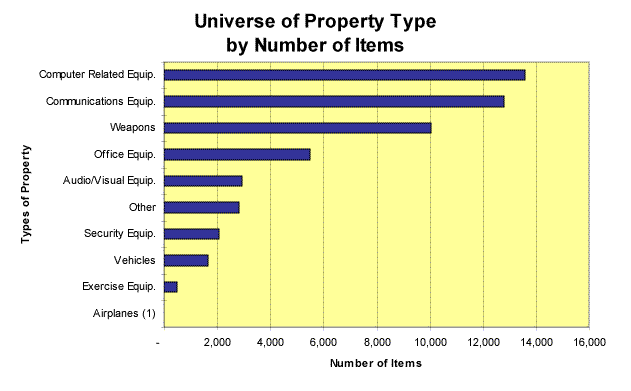
II. THE USMS FIXED ASSET ACCOUNTS WERE MISSTATED
Fixed assets comprise a significant portion of overall USMS resources. We found that the USMS fixed asset account was misstated by at least $112 million, excluding the affect of accumulated depreciation.9 Serious misstatements concerned capitalized leases, leasehold improvements, vehicles, and aircraft. This was due to an inadequate system without proper controls and poor communication between the USMS and JMD. The effect is that financial information used by USMS management for decision making is unreliable and causes inaccuracies in the financial statements.
Congressional Requirements for Financial Statements
The Chief Financial Officers Act of 1990 was created to bring more effective general and financial management to governmental operations. The Act specifically requires the production of complete, reliable, timely and consistent financial information.
The Government Management Reform Act of 1994 requires the submission of Departmentwide audited financial statements for FY 1996, and Governmentwide audited financial statements for FY 1997. For much of the Department, including the USMS, FY 1996 will be the first time that financial statements have been prepared and audited.10 The Federal Financial Management Improvement Act of 1996 mandates that agencies implement and maintain financial management systems and use applicable federal accounting standards that support the financial statements beginning in FY 1997. The Office of Management and Budget provides specific guidance on the form and content of the financial statements. An OMB bulletin states that property, equipment and leasehold improvements are an integral part of the financial statement.
To meet this congressional mandate, the USMS entered into a multi-year agreement with JMD. According to USMS officials, the agreement required the USMS to pay JMD $1.6 million annually to maintain the USMS accounting records and aid in developing its financial statements. Part of JMD's responsibility was to maintain the fixed asset accounts with data provided by the USMS. As of October 1, 1994, all capitalized property, costing $25,000 or more, with an estimated life of 2 years or more, was to be included in the fixed asset accounts.11
Capitalized Property Record System
The Justice Management Division maintained a database, separate from FMIS, to support the fixed asset account on the general ledger. This separate database was necessary because FMIS did not capture accountable property valued at $25,000 or more from its PMS module. The JMD annually reconciled its separate database to the PMS and, as a result, posted year end adjusting entries to the fixed asset account. However, these adjusting entries did not include capitalized leases or leasehold improvement because they were not tracked by either the USMS PMS or any of JMD's systems. Hence, the fixed asset account reflected a zero balance for these capitalized leases and leasehold improvements. These omissions caused the majority of misstatements in the fixed asset portion of the financial records.
Therefore, in order to test the validity of the fixed asset balance, we reviewed the USMS FY 1995 trial balance12 to assess the accuracy of the balances for: (1) leasehold improvements; (2) capitalized leases; and (3) aircraft, vehicles, and other high cost property. Within each of these categories, we concentrated on transactions valued at $25,000 or more for four of the largest program areas in the USMS: Court Security, Operations, Administration, and JSD. Our review of the FY 1995 trial balance and our findings on leasehold improvements, capitalized leases, and aircraft, vehicles, and other high cost property follow.
USMS FY 1995 Trial Balance
We reviewed the FY 1995 trial balance to determine whether it was accurate for fixed assets. As shown on the next page, the trial balance was materially misstated by at least $112 million in the aggregate, not including accumulated depreciation on these assets.
USMS TRIAL BALANCE AGGREGATE ERROR
USMS FIXED |
JMD FY 1995 BALANCE AS OF 9/30/95 |
AGGREGATE ERROR |
| Capitalized Leases | 0 |
$30,446,556 |
| Equipment | $4,492,424 |
1,411,668 |
| Transportation Equipment | $17,159,797 |
27,885,255 |
| Leasehold Improvements-Buildings | 0 |
52,629,900 |
|
$112,373,379 |
|
Our review revealed that five asset accounts maintained by JMD for the USMS were
substantially misstated for all categories we tested. Misstatement errors ranged from an
understatement of $1 million for equipment to an understatement of about $53 million for
leasehold improvements. The primary reasons were: (1) FMIS did not allow for the
capitalized property, and (2) the USMS did not implement a method to notify JMD of all
capitalized property it acquired. JMD relied on the USMS property system which did not
include all capitalized assets.
We were unable to determine the actual or estimated balance for the total fixed asset
accounts for several reasons.13 Specifically, the
misstatement was a cumulative error consisting of transactions not being reported in the
USMS PMS. In addition, the accounting system was not capturing capitalized items in
accordance with JMD capitalization policy of recording items that have a cost of $25,000
or more on the general ledger. In our judgment, however, the errors we identified were of
sufficient magnitude to call into question the accuracy of the entire fixed asset account.
Leasehold Improvements
The USMS reported a zero balance in this fixed asset account, however, our testing determined the USMS has about $53 million in potential leasehold improvements.14 The major categories of leasehold improvements we identified were for courthouse renovation and security systems.
Courthouse Renovation. This category includes physical renovations to courthouses such as barriers, jail cells, elevators, etc. For the period 1989 to 1995, the USMS Space Management Branch under the Administrative Services Office had obligated funds totaling almost $42 million for projects to improve USMS space within the courthouses.15 JMD staff stated that they did not receive proper documentation from the USMS to be able to ascertain whether the building improvements should be capitalized.
Security Systems. These are primarily cameras, monitors, alarm systems, and electronic monitoring systems operated by the USMS Court Security Division and Space Management Branch. We reviewed expenditures for the period 1993 through 1995. None of the expenditures were capitalized and included in the fixed asset accounts. However, USMS records showed expenditures of almost $11 million when the account balance was zero. JMD staff stated that they did not receive the necessary documentation from the USMS to include the amounts in the fixed asset account.
Senior USMS management advised us on December 4, 1996, that OMB intended to remove the majority of leasehold improvement funds from the USMS budget, beginning in FY 1998. USMS believes it is OMB's position that since GSA owns the buildings and will start paying for future renovations of these buildings starting in FY 1998, GSA should carry these assets on its financial statements. However, the costs still need to be accounted for by the USMS through FY 1997 or until they are transferred.
We identified four capital leases amounting to over $30 million that were not reported on the fixed asset account balance. These leases were for an aircraft hanger in Oklahoma City ($17.5 million), a Special Operations Group facility ($5.7 million), and two leases for JSD facilities valued at $7.7 million. We believe the leases we identified above represent only a portion of all capital leases the USMS maintains nationwide.
Aircraft, Vehicles, and Other High Cost Property
Aircraft. The USMS maintains a fleet of 14 aircraft with a total acquisition value of $27 million. The fleet is an asset of the organization and its value should be correctly included on the financial statements. The fixed asset account did not have a category for aircraft, rather they were classified as motor vehicles.
We identified two Saberliner aircraft still reported in the USMS PMS and the fixed asset account at a cost of $4.5 million when the aircraft had been destroyed in a flood16. These aircraft should have been removed from the USMS PMS and the JMD maintained fixed asset account balance.
A Boeing 727 aircraft was carried on the fixed asset account at $1.7 million. In FY 1995, the USMS believed that this plane was undervalued and did not reflect future lease-purchase payments. The USMS wanted to value the plane at $9.5 million. However, JMD refused at the time to make the adjustment, questioning its legitimacy. The issue was subsequently resolved during FY 1996 and an adjustment was made by JMD.
We identified over $10 million in improvements made to USMS aircraft during FYs 1993 through 1995. The improvements were omitted from the fixed asset account and included new engines and avionics.
Vehicles. We identified 21 JSD armored vehicles valued at a total of about $1.6 million that were not reported in the USMS PMS and, therefore, omitted from the fixed asset account.
Other High Cost Property. USMS records for Court Security and JSD indicated over $1 million in property that was omitted in the fixed asset account. The type of property included courthouse x-ray equipment and computer equipment.
The DOJ is in the process of preparing Departmentwide audited financial statements to comply with the Government Management Reform Act of 1994. A $112 million misstatement in the USMS fixed asset account is a serious weakness that needs to be corrected to ensure adequate financial statements. This misstatement occurred because the JMD system did not adequately account for capitalized property and there was poor communication and coordination between JMD and the USMS.
Recent Action on Fixed Asset Deficiencies
To its credit, the USMS began taking immediate corrective action when notified of the problems. Due to the magnitude of the fixed asset deficiencies we identified, we sent memoranda to the USMS and JMD, advising them of this problem. The USMS responded stating that a task force has been created to address and rectify the problem. Phone conversations with the leader of the task force indicated that all adjustments pertaining to equipment and transportation equipment were made. According to the USMS, approximately $10 million in capital leases have been added to the general ledger. Work still remained on leasehold improvements and capitalized leases. The JMD did not respond to our notification.
An adjusting entry was made by JMD in October 1996 to correct the equipment and transportation equipment balances based on information provided by the USMS. However, the account balance for leasehold improvements had not been updated.
In December 1996, we were advised that the USMS planned to sever its relationship with JMD and prepare and maintain its own financial records. The USMS will not implement its own system until FY 1998, at the earliest. In our judgment, an interim notification system needs to be implemented to assure that JMD receives fixed asset account information in an accurate and timely manner.
We recommend that the Director, USMS:
5. Provide JMD with the necessary information to properly adjust the current fixed asset account balances.
Resolved. The USMS has already provided JMD with some information, and indicated that the remaining information regarding JSD facilities and reimbursable work authorizations will be provided by May 31, 1997.
To close this recommendation, please provide the OIG with the adjusted balances.
6. Implement a notification procedure to ensure that JMD is provided with data to ensure the future accuracy of the fixed asset account balance.
Resolved. The USMS indicated three initiatives to improve the data in the fixed asset account balance. Staff will: (1) consult with JMD and potentially raise the threshold balance for capitalizing equipment from $25,000 to $100,000; (2) establish improved processes to permit USMS procurement personnel to alert property and financial personnel of the purchase of capitalized property; and (3) utilize the internal USMS Program Review Division to ensure capitalized property is accounted for. The USMS also agreed to meet with JMD on a quarterly basis to ensure that capitalized property is reflected on the general ledger.
To close this recommendation, please provide documentation on the:
(1) results of the threshold balance increase, (2) process that USMS procurement personnel
will utilize to identify capitalize purchases, and (3) additional steps the USMS
Program Review Division will initiate to review the existence of capitalized property in
its reviews. In addition, please provide documentation supporting the quarterly reviews
being held with JMD to disseminate necessary information.
SCHEDULE OF DOLLAR-RELATED FINDINGS
| QUESTIONED COSTS | AMOUNT | PAGE |
| Projected acquisition cost of property not located. | $3,482,351 | 4 |
| Projected idle property. | $4,378,878 | 12 |
| Total Questioned Costs | $7,861,229 |
______________________
QUESTIONED COSTS are defined as expenses incurred that do not comply with law or other official requirements, or are unsupported by adequate documentation, or are unnecessary or unreasonable for the intended purpose. They can be recoverable or non-recoverable.
AUDIT SCOPE AND METHODOLOGY
This audit was conducted in accordance with Government Auditing Standards issued by the Comptroller General of the United States. The primary objectives of the audit were to review the adequacy of the USMS controls over accountable property through its PMS and the ability to accurately report assets in the general ledger account. Specifically, the objectives were to determine the accuracy, reliability, internal controls and compliance with laws and regulations as it pertained to: (1) property information in the USMS PMS; and (2) the USMS general ledger, fixed asset account maintained by JMD.
1. USMS Property Management System
The audit was based on data obtained from the USMS PMS as of June 6, 1996. Our tests of the PMS, a module of the Financial Management Information System (FMIS), included: (1) reviewing applicable laws, policies, regulations, manuals, and memoranda; (2) interviewing responsible personnel; (3) testing internal controls; (4) reviewing property listings, records and files; and (5) to a limited extent, reviewing invoices and accounting records. These tests were performed in the following four areas as they pertained to the PMS:
Our first area of testing required that we physically verify the existence of those property items that were recorded in the PMS. Furthermore, of the property items that were physically verified, we determined, with the assistance of USMS personnel, whether those items were utilized or idle. In order to make these types of determinations, relating to the PMS as a whole (rather than select locations with no projection capability), we incorporated a two-stage statistical sampling model. Please refer to Appendix VI for further detail on the statistical sampling model and the corresponding results.
The second area of testing included tracing property physically located at the sites reviewed to the PMS. We tested 616 items that were found at the 23 locations reviewed. The audit team used judgment in selecting items from the floor in order to trace those items to the PMS. If the item did not appear in the PMS as of June 6, 1996, we made additional effort to review documentation that would indicate that paperwork was prepared and submitted for processing. When selecting an item from the floor, we made a determination, with the assistance of USMS personnel, whether the item was being utilized or idle. The valuation of items tested was based on an evaluation of comparable items in the office inventory.
The third area of testing included identifying accountable property recently purchased by office personnel, verifying whether it was added to the PMS, and physically verifying its existence. Our review of purchased property concentrated on, but was not limited to, the period July 31, 1995 to March 31, 1996. We tested 147 property items recently purchased at the sites reviewed.
The fourth area of testing included calculating the average length of time that updates and changes to the PMS became effective. The first calculation determined how long the office took to prepare and submit the applicable paperwork to initiate the update or change in the PMS. The second part of the calculation determined how long USMS Headquarters took to enter the property update or change in the PMS.
2. USMS's Fixed Asset Ledger
The USMS Fixed Asset Ledger is maintained by JMD. For our review, (see Finding 2) we
interviewed and analyzed data from the USMS and JMD. Our review focused on the fixed asset
portion of the general ledger trial balance for FY 1995, as of February 26, 1996, which
was the latest information available at the time of our review.
Audit work was conducted at USMS Headquarters and at JMD and included interviews of accounting, administrative and operational personnel and review of pertinent records. The review of records and interviews of personnel were conducted at Headquarters Court Security, JSD, Space Management and Air Operations Divisions.

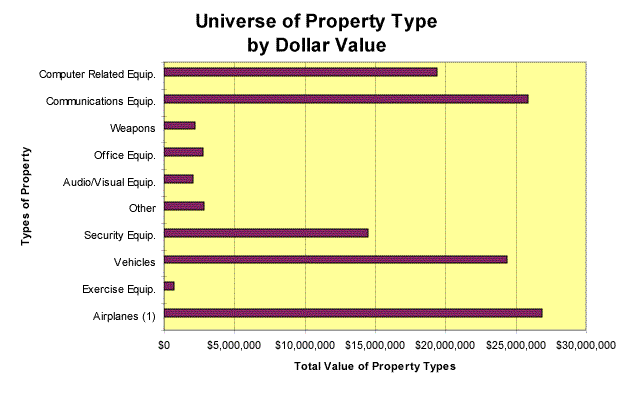
(1) |
= Total of 14 Airplanes |
LIST OF SITES REVIEWED
| USMS Office17 | Total Number of Items in Inventory |
Total Dollar Value of Inventory |
Sample Size |
Total Dollar Value of Sample |
| S/California | 573 |
$ 1,376,480 |
40 |
$ 138,557 |
| Colorado | 420 |
722,742 |
33 |
64,625 |
| Court Security Wash. D.C. | 42 |
84,436 |
29 |
47,045 |
| D.C. Superior Court | 649 |
1,239,188 |
40 |
70,798 |
| S/Georgia | 431 |
776,199 |
33 |
75,449 |
| N/Illinois | 710 |
1,144,150 |
40 |
31,300 |
| S/Indiana | 386 |
648,913 |
33 |
39,427 |
| S/Iowa | 230 |
407,369 |
33 |
33,126 |
| W/Kentucky | 359 |
576,911 |
33 |
47,606 |
| Massachusetts | 488 |
985,869 |
40 |
79,410 |
| E/Michigan | 565 |
1,180,142 |
60 |
98,376 |
| W/Michigan | 341 |
611,766 |
33 |
83,959 |
| E/New York | 544 |
1,114,654 |
40 |
70,428 |
| S/New York | 1,087 |
1,865,862 |
40 |
96,116 |
| E/Pennsylvania | 462 |
979,275 |
60 |
151,593 |
| W/Pennsylvania | 372 |
645,855 |
33 |
56,603 |
| Special Operations Group | 1,746 |
2,129,579 |
33 |
52,135 |
| M/Tennessee | 233 |
386,889 |
33 |
35,063 |
| S/Texas | 915 |
1,764,960 |
40 |
36,990 |
| E/Virginia | 669 |
1,034,207 |
40 |
56,963 |
| Witness Security Boston | 170 |
328,450 |
32 |
58,572 |
| Witness Security Dallas | 6 |
6,761 |
6 |
6,761 |
| USMS Headquarters18 | 7,013 |
11,509,508 |
150 |
209,603 |
| Totals | 18,411 |
$31,520,165 |
954 |
$1,640,505 |

STATISTICAL SAMPLING MODEL
The purpose of the statistical sampling model was to estimate the number and dollar value of items not found and of items idle in the USMS. We tested all items valued at $950,000 or more which represented 9 airplanes valued at $26 million. By separating the highest valued items from the PMS, we ensured a 100 percent coverage of these few but expensive property items. The remaining property, less items with no value (499 items), was the audit universe for our statistical sample. This audit universe was defined as 51,460 items with a value of $95.4 million.
We used a two-stage statistical sampling design with sites and items being randomly selected. At the first stage, the universe was divided into three strata: Headquarters, large district offices, and all other offices. Besides Headquarters, 22 sites were randomly selected as locations for audit testing. Of these 22 sites, 10 were large district offices, 8 were small district offices, and the remaining 4 were Headquarter field offices. For further information on the locations reviewed, see Appendix III, List of Sites Reviewed. For stratification purposes, we defined large district offices as having $950,000 or more in total property while small district offices had less than $950,000 in total property. At the second stage, once the sites were selected, the property was stratified into three categories: weapons, computers, and all other items. Because of the low tolerance that exists for missing weapons and the risk of sensitive data and information on the hard drives of computers being compromised, we separated these property items from the remaining types of property to ensure adequate coverage. We randomly selected for review 333 weapons, 277 computers, and 344 other items for a total sample of 954 items with a value of $1,640,505.
Within Headquarters, items were randomly selected regardless of the office they were assigned to. As a result, sample items selected for physical verification were spread throughout the different Headquarters offices. Nevertheless, we concentrated our internal control testing in the following five offices: Court Security, Enforcement, Information Technology Services, Radio Communications, and Judicial Security Division.
If physical verification of an item was not possible, we utilized confirmation letters to verify the existence of that item. If an item was transferred, excessed, or sent out for repair, we confirmed the property item's status with applicable paperwork. We did not use independent appraisals to determine the value of property, rather, we used the value as recorded in the PMS.
From the universe of 51,460 property items valued at $95,435,665 we tested a random sample of 954 items valued at $1,640,505. Of the 954 items sampled, 64 items at a value of $128,289 could not be found and 131 items at a value of $193,495 were idle.
Because our sample was statistically valid, we could project with 90 percent confidence that for the entire universe:
Our confidence level means that there is a 90 percent probability that our sample test results contain the true condition of the universe within the above stated ranges of items and dollars.
ACRONYMS AND DEFINITIONS
| Account | A systematic arrangement that shows the effect of transactions and other events on a specific asset or equity |
| Accountable Property | An item with an original acquisition cost of $200 or more, is complete in itself, and has a life expectancy of 1 year or more |
| ADP | Automated Data Processing |
| Capitalized Asset | An asset costing $25,000 or more and has an estimated life of 2 years or more |
| Capitalized Lease | A lease that has any one of these criteria: it transfers ownership of the property to the lessee; it contains a bargain purchase option; it is equal to 75 percent or more of the estimated economic life of the leased property; or the present value of the minimum lease payments equals or exceeds 90 percent of the fair value of the leased property |
| FMIS | Financial Management Information System |
| Fixed Asset | An asset that has an expected useful life of more than 1 year and is acquired for use in the operation of an agency or program |
| General Ledger | A collection of all the asset, liability, revenue, and expense accounts |
| ITS | Information Technology Services Office |
| JMD | Justice Management Division |
| JSD | Judicial Security Division |
| Leasehold Improvements | An improvement or betterment that increases the usefulness of leased property e.g. air-conditioning |
| Ledger | The book or computer printout containing the accounts |
| Property Custodian | The person responsible for all property management actions taken for property in a particular location |
| Physical Verification | An audit test where an entry on the inventory listing is traced to the item itself or to documentation attesting to the item's existence and location |
| PMS | Property Management System |
| Trial Balance | List of all open accounts in a ledger that have balances |
| USM-134 | Affidavit regarding lost, stolen, or unauthorized destruction of government property, used by USMS |
| USM-325 | Hand Receipt, document used to track property issued to individuals |
| Walk Through | Audit test whereby an item of accountable property is selected at random and traced to the inventory listing |
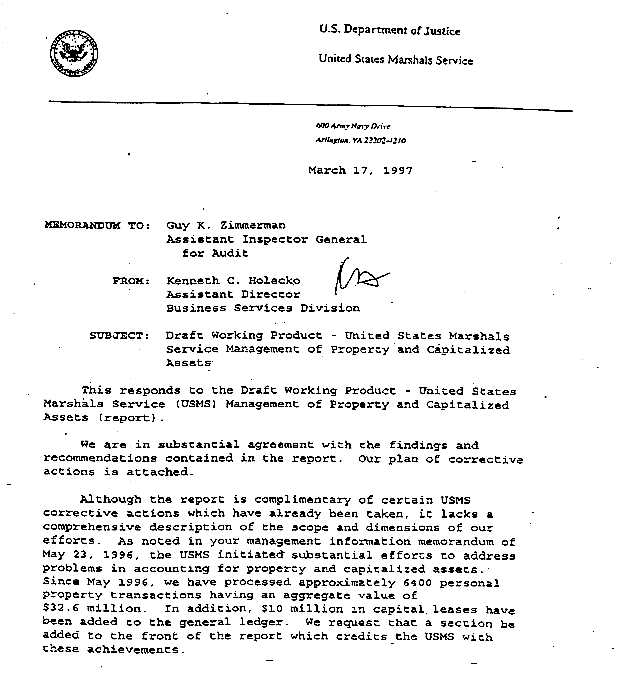
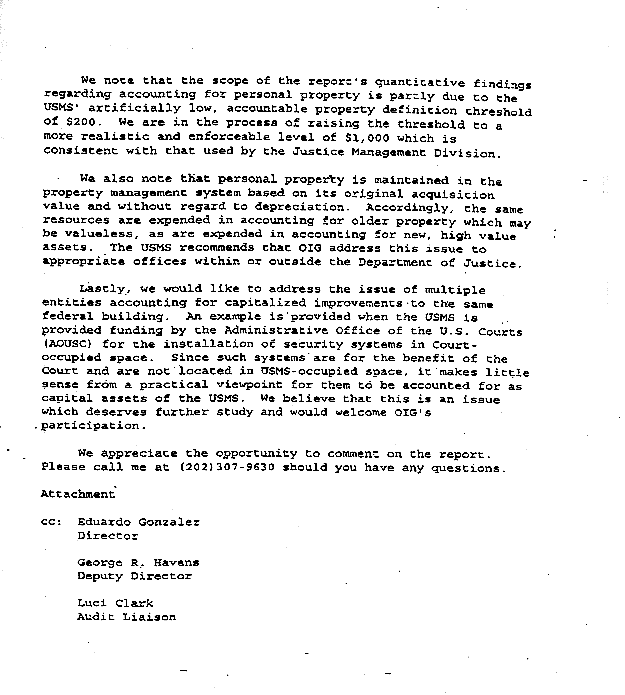
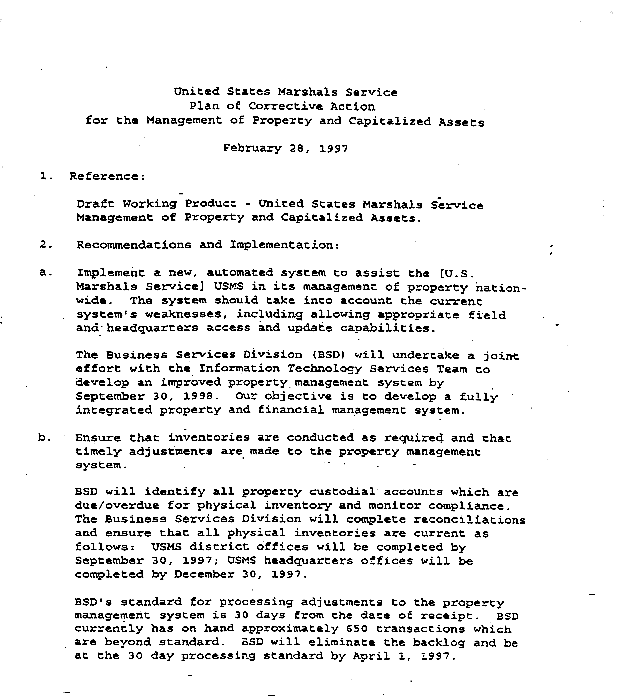
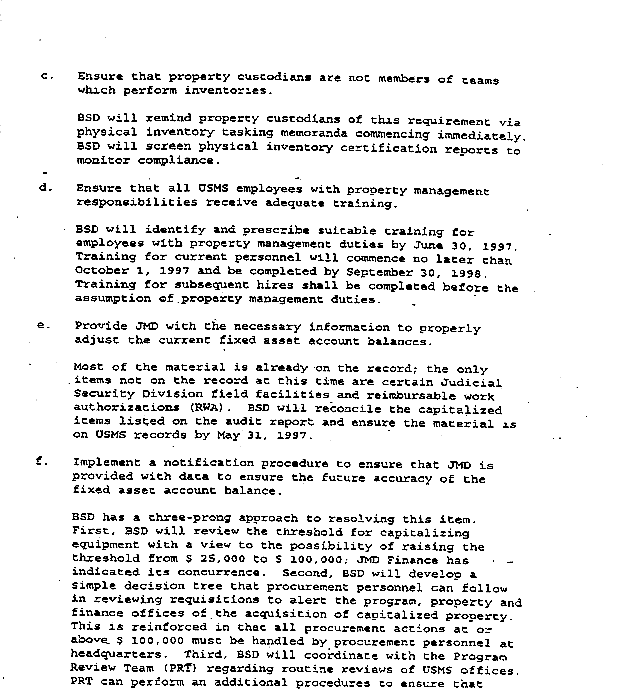
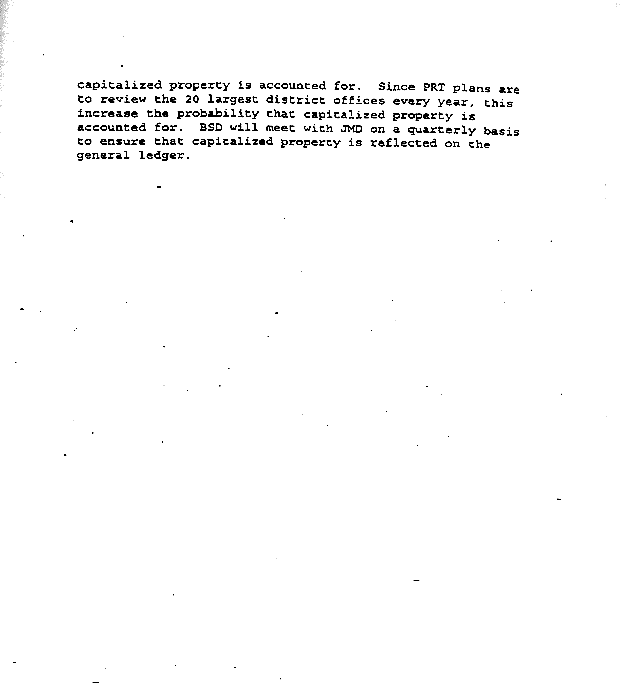
9 Accumulated depreciation is the amount of depreciation that has been charged against an asset from the date of acquisition.
10 For fiscal year 1996, the USMS will not have a separate audited financial statement but rather their information will be included within the Offices/Boards/Divisions/USMS reporting entity.
11 Prior to October 1, 1994, capitalized property was defined as property costing over $5,000 with an estimated useful life of 2 years or more.
12 A trial balance is a list of all open accounts in the ledger with balances.
13 The fixed asset account will be reviewed in greater detail in our FY 1996 Financial Statement Audit of the Offices/Boards/Divisions/USMS.
14 This amount consisted of $42 million in obligations and $11 million in expenditures.
15 The expenditure information on these obligations was requested from the USMS, however, this information was never provided.
16 The flood occurred in July 1993 while a contractor had possession of the aircraft. Litigation occurred and a settlement was reached in September, 1996 with the contractor retaining possession of the aircraft.
17 N,S,E,W equates to Northern, Southern, Eastern, and Western.
18 These are the numbers for the Headquarters offices in which we did verification work.
#####